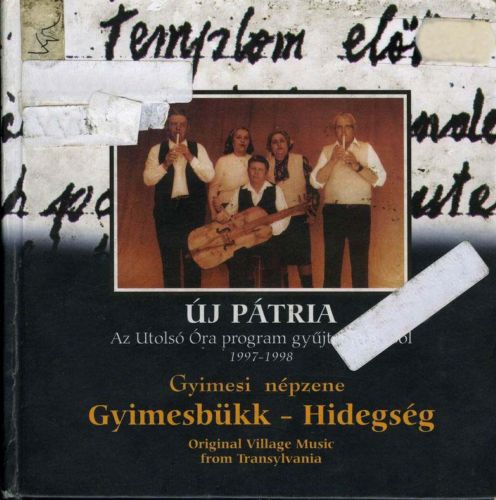

Gyimesbükk - Hidegség (Ghimes). Original Village music from the Eastern Carpathians of Transylvania:
Gyimes (in Romanian, Ghimes) is located on the border of Hargita and Bákó counties, northeast of the town of Csíkszereda (Miercurea Ciuc). It lies beyond the Carpathian watershed, in the easternmost reaches of what, according to Hungarian history, was known as Csík County. In the high mountainous terrain, agriculture can only play a secondary role, that's why there, living off the land means primarily animal husbandry and forestry. The Gyimes man is famous for his knowledge of wood, he is a fantastic carpenter, and knows everything about animals and shepherding. And amongst shepherds there are always a lot of good flute players. The people of Gyimes love to have a good time, they know a lot of tunes and their whole culture, thus the music as well, is full of elements from Central Asia or the Middle Ages.
The music and dance culture of the Csángó people of Gyimes, despite the ethnic variations, is quite uniform. Most of their vocabulary of melodies can be considered rather archaic, unique variations of Csík Székely melodies. The people of the nearby Felcsík area, often say “that’s a Csángó tune” about an old melody, which is no longer fashionable there, but which is still popular amongst the traditional faithful Gyimes people. Most of the melodies are old Hungarian vocal and instrumental melodies which accompany the old couple dances and solo men’s dances – lassú and sebes magyaros (slow and fast Hungarian), csárdás, kettos jártatója a nd sirüleje, and men’s dances; féloláhos and verbunk. The book by Zoltán Kallós and György Martin, “Tegnap a Gyimesbe jártam…” presents an invaluable selection of their lament type songs.
The Gyimes vocabulary of dances is filled out with line dances (the “hejszák”) and couple dances of bourgeoise origin locally referred to as “aprók”. The line dances are accompanied by melodies more of Balkan or Romanian origin with fewer tunes of Hungarian origin, whereas the “aprók” are accompanied by melodies of German or city style composed melodic origin. They do a dance imitating bears at wedding which is called “medvés” (the bear dance).
Their singing and instrumental style of performance exhibit a characteristically strong tendency for ornamentation and variations. The richly shaped instrumental melody is not accompanied by harmony, rather by a sound from the gardon – a folk cello – in richly varied rhythms. The first written reference to this stringed instrument which used as a rhythm instrument by hitting the strings with a wooden stick, is from the time of the principality of Transylvania (that is the 16th and 17th centuries). Today this style has largely died out in the Székely areas of Transylvania, but in Gyimes there are quite a few excellent gardon players still playing. One of the best amongst them, is the musician playing on this recording, János Tímár.
Next to the gardon, the most important traditional instruments of the Gyimes people are the violin and two types of flutes: a typical six holed flute and the so-called two necked flute or double flute.
The singers, two sisters from Gyimesbükk were always known as being good singers. They are Éva Karácsony and Mária Kócsár or “the Kutas girls” as they were called when they were young. “The Kutas girls could always be heard from far away, if they were in the forest, they were always singing.” This comment was heard by the writer of these lines in 1998 in the Pika Bar in Bálványospatak, from very a serious man who never would have had the occasion to have the same route through the forest as the Kutas girls…
The life of a person from Gyimes offers endless possibilities for singing. A person can sing while walking alone in the forest, or while doing chores around the house, they can sing in the pub, at the spinning bee, at a wedding, at a ball, at a christening, at the farewell dinner for boys going into the army, at a pig butchering; they can sing on the way home on top of the hay wagon, when there’s something the matter or when they’re happy about something, when they’re afraid and when they’re bored. The life of a person from Gyimes, like anyone who still lives the traditional lifestyle is permeated with music. The language system built on the songs is taught to the children like the language itself. They hear it constantly, and learn it without even realizing it, thus making the music one with their mother tongue. When they sing together it is particularly easy to feel how similarly, naturally and easily, they express the ornamentation, the rhythms and the seemingly complicated system. This can mean, a symmetrical csárdás melody, the ‘limping’ rhythm of the lassú magyaros, or perhaps the free talking rhythm of the lament tunes.
In the musical life of the Gyimes people, the flute played a big role. Viktor Tímár has told me, that like the rest of the children, by the time they were 5 or 6 years old they were already spending the whole summer with their grandfather at the pasture up in the mountains where the Gyimes people keep their animals from the spring through the fall. That’s when he was given his first flute. It was the general practice to give little boys their first flute upon reaching the age of five or six. And when they all went upo to the summer lodging, they all took their flutes. So it’s no wonder there were so many good flute players – ones who could make a tune “bloom”, could “play out the melody’s ornamentation too” and “play it into the feet”.